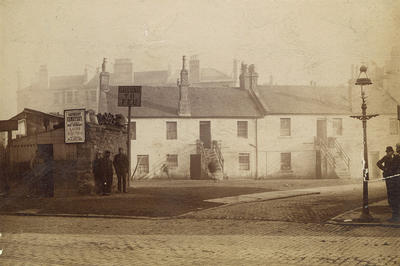Strathbungo began life as a small village on the road south from Glasgow to Pollokshaws, whose residents were crofters, weavers, or miners. The village was centered on the crossroads we now call Pollokshaws Road and Allison Street/Nithsdale Street. The land about was mostly the property of the Maxwells of Pollok House, who preferred the name Marchtown, but it was Strathbungo that stuck.
In the mid 19th Century a plot of land south west of the village was sold by the Stirling-Maxwells to developers, and thus began the building of the current suburb of Strathbungo, with its long Victorian sandstone terraces known as the Squares, and the terraces of Moray Place. The first of these was designed by Glasgow’s famous architect, Alexander “Greek” Thomson, who moved in at No 1 Moray Place. The development was originally known as Regents Park, but again it was the name Strathbungo that stuck. The development was not completed however until the Gardens were built in 1929, to a rather different style in keeping with the idea of the 20th Century garden suburb.
Meanwhile the village, which once stood proud and alone on the moor south of Glasgow, was consumed by the city’s Victorian growth, and swallowed up by neighbouring Crosshill and Govanhill. Consequently the name Strathbungo now usually refers to the suburb alone, bounded by the railway line, Nithsdale Drive, Pollokshaws Road and Titwood Road. This has stirred up some debate, including on this site, as to where Strathbungo is, but it has no legal definition I can find, so it can be wherever you want it to be. The one exception is the legally defined boundary of the Strathbungo and Shawlands Community Council, but even that doesn’t define Strathbungo itself. To see the boundary, try this Council look up service. You will need to enter your address to show anything.
In the 1960s plans were drawn up to build a motorway through the area, all part of Glasgow’s obsession with modernity, and distaste for its historical architecture. Thus began the conservation movement, and Strathbungo was one of the pioneers. The Strathbungo Society was born in 1971 to protect and regenerate what had become an unwanted slum of bedsits and cheap boarding houses, and Strathbungo became one of Scotland’s earliest Conservation Areas in 1973. It was the first in Glasgow, along with Pollokshields.
That regeneration has been so successful that Strathbungo is a vibrant community and popular place to live, and the Society is as much involved in organising community events as it is in conservation.
Bygone Bungo
A much fuller history of Strathbungo can be found on our sister site Bygone Bungo, which contains a plethora of old photographs and maps, a full history of the development of the area and articles of interest.
It also features a large searchable database of each street and house, with details of former residents from the Victorian era and early 20th Century. Enter your address, and see who lived there before you!




Recent Comments